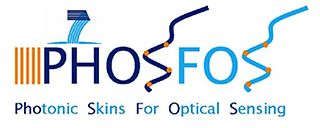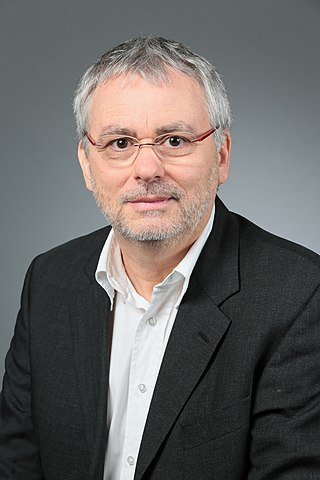
Photonics is a branch of optics that involves the application of generation, detection, and manipulation of light in form of photons through emission, transmission, modulation, signal processing, switching, amplification, and sensing. Photonics is closely related to quantum electronics, where quantum electronics deals with the theoretical part of it while photonics deal with its engineering applications. Though covering all light's technical applications over the whole spectrum, most photonic applications are in the range of visible and near-infrared light. The term photonics developed as an outgrowth of the first practical semiconductor light emitters invented in the early 1960s and optical fibers developed in the 1970s.

Corning Incorporated is an American multinational technology company that specializes in specialty glass, ceramics, and related materials and technologies including advanced optics, primarily for industrial and scientific applications. The company was named Corning Glass Works until 1989. Corning divested its consumer product lines in 1998 by selling the Corning Consumer Products Company subsidiary to Borden.

An optical fiber, or optical fibre, is a flexible glass or plastic fiber that can transmit light from one end to the other. Such fibers find wide usage in fiber-optic communications, where they permit transmission over longer distances and at higher bandwidths than electrical cables. Fibers are used instead of metal wires because signals travel along them with less loss and are immune to electromagnetic interference. Fibers are also used for illumination and imaging, and are often wrapped in bundles so they may be used to carry light into, or images out of confined spaces, as in the case of a fiberscope. Specially designed fibers are also used for a variety of other applications, such as fiber optic sensors and fiber lasers.
A photonic integrated circuit (PIC) or integrated optical circuit is a microchip containing two or more photonic components that form a functioning circuit. This technology detects, generates, transports, and processes light. Photonic integrated circuits utilize photons as opposed to electrons that are utilized by electronic integrated circuits. The major difference between the two is that a photonic integrated circuit provides functions for information signals imposed on optical wavelengths typically in the visible spectrum or near infrared (850–1650 nm).

Fiber-optic communication is a method of transmitting information from one place to another by sending pulses of infrared or visible light through an optical fiber. The light is a form of carrier wave that is modulated to carry information. Fiber is preferred over electrical cabling when high bandwidth, long distance, or immunity to electromagnetic interference is required. This type of communication can transmit voice, video, and telemetry through local area networks or across long distances.
The National Optics Institute (INO) is a Quebec City-based private non-profit corporation founded in 1988. INO is a technological design and development firm that deals in optics and photonics for SMEs and large corporations in Canada and around the world. INO has 147 patents granted. In addition, over 103 other patent applications have been submitted and are awaiting approval. INO was recognized as a Centre of Excellence and Innovation by the Canadian government.

Electronic textiles or e-textiles are fabrics that enable electronic components such as batteries, lights, sensors, and microcontrollers to be embedded in them. Many smart clothing, wearable technology, and wearable computing projects involve the use of e-textiles.

Iolon Inc. was a manufacturer and designer of tunable lasers and optical devices. Its headquarters were in San Jose, California. Its products included the Apollo line of lasers, as well as optical switches, polarization controllers, tunable filters, spectral monitors, and universal transponders. Iolon raised over US$85 million in capital during the dot-com bubble of 1995–2001, but faltered as the telecommunications market tightened after the bubble burst. Iolon's remaining assets were bought by Coherent in 2005, for $5 million.
Chiral Photonics, Inc., founded in 1999, is a photonics company based in Pine Brook, New Jersey, in the US.
A fiber-optic sensor is a sensor that uses optical fiber either as the sensing element, or as a means of relaying signals from a remote sensor to the electronics that process the signals. Fibers have many uses in remote sensing. Depending on the application, fiber may be used because of its small size, or because no electrical power is needed at the remote location, or because many sensors can be multiplexed along the length of a fiber by using light wavelength shift for each sensor, or by sensing the time delay as light passes along the fiber through each sensor. Time delay can be determined using a device such as an optical time-domain reflectometer and wavelength shift can be calculated using an instrument implementing optical frequency domain reflectometry.
Civionics is the combination of civil engineering with electronics engineering, in a manner similar to avionics and mechatronics. An emerging discipline, the main application area of civionics is currently the use of electronics for structural health monitoring (SHM) of civil structures, particularly photonics.

PhoSFOS is a research and technology development project co-funded by the European Commission.

Kenneth O. Hill is a Mexican Canadian physicist who specializes in the field of photonics. In the late 1970s, he discovered the phenomena of photosensitivity in optical fiber and has worked extensively in its applications. He first demonstrated Fiber Bragg gratings and their applications in optical communication and optical sensor systems. Further areas of his discovery and innovation include the phase mask technique for grating fabrication, fiber grating dispersion compensators, and wavelength selective fiber filters, multiplexers and demultiplexers. This field of research has led to the ability to create high speed fiber optic networks as well as many other communication applications that have revolutionized the telecommunications industry.

Tower Semiconductor Ltd. is an Israeli company that manufactures integrated circuits using specialty process technologies, including SiGe, BiCMOS, Silicon Photonics, SOI, mixed-signal and RFCMOS, CMOS image sensors, non-imaging sensors, power management (BCD), and non-volatile memory (NVM) as well as MEMS capabilities. Tower Semiconductor also owns 51% of TPSCo, an enterprise with Nuvoton Technology Corporation Japan (NTCJ).
Qualitrol is a condition monitoring technology company headquartered in Fairport, New York. Qualitrol manufacturers and distributes partial discharge monitoring, asset protection equipment and information products for the electrical generation, transmission and distribution industries.

Michael Morris is an American biochemist, oceanographer and businessman, who has designed, developed and marketed new applications of optical sensing technology and spectroscopy. He has founded several companies including pHish Doctor, Ocean Optics Inc. (OOI), and SpectrEcology.

John E. Bowers is an American physicist, engineer, researcher and educator. He holds the Fred Kavli Chair in Nanotechnology, the director of the Institute for Energy Efficiency and a distinguished professor in the Departments of Electrical and Computer Engineering and Materials at University of California, Santa Barbara. He was the deputy director of American Institute of Manufacturing of Integrated Photonics from 2015 to 2022.
Optelecom-NKF, Inc. is an American company that designs, manufactures, and markets high-bandwidth communications products, financial market data information, and business video systems.

Luc Thévenaz is a Swiss physicist who specializes in fibre optics. He is a professor of physics at EPFL and the head of the Group for Fibre Optics School of Engineering.
The Fiber Optic Sensing Association (FOSA) is a nonprofit industry association that promotes fiber-optic sensing technology. It was founded in April 2017 in Washington, D.C. and has a membership of 16 companies and universities.










